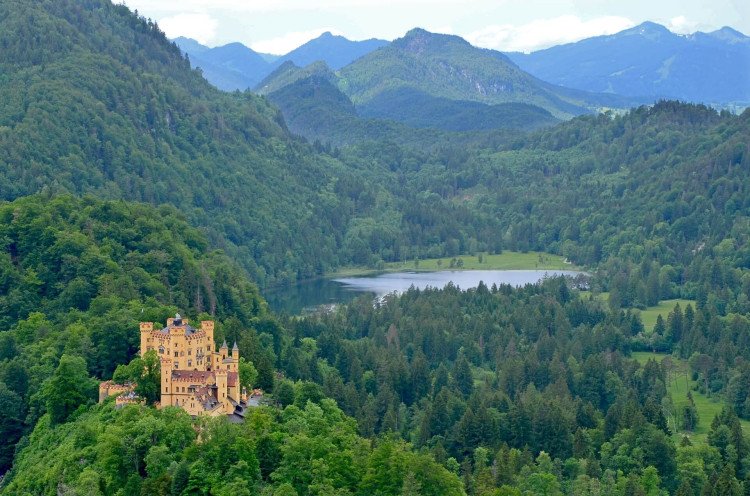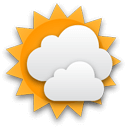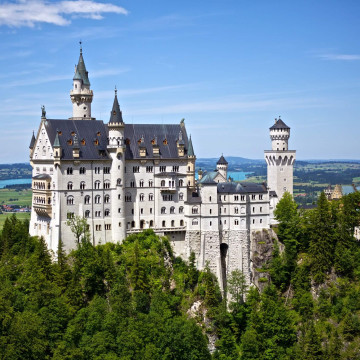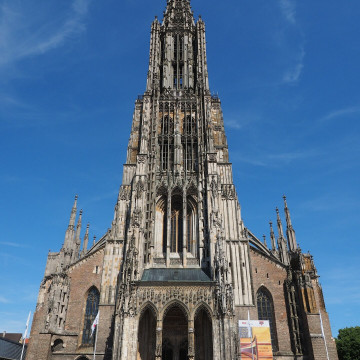Hohenschwangau Castle - one of four castles of Louis II the Madman
Where is located Hohenschwangau Castle?
Address of Hohenschwangau Castle is Alpseestraße 12, Schwangau, Germany
show on map
When was built Hohenschwangau Castle?
Built date of Hohenschwangau Castle is XII century

Facts, informations and history of Hohenschwangau Castle
Hohenschwangau Castle is a 19th century fortress in southern Germany. It was a childhood residence of King Louis II of Bavaria and was built by his father, King Maximilian II of Bavaria. Hohenschwangau is the smallest of the four eccentric creations of Ludwig Bavarian (Neuschwanstein, Linderhof, Herrenchiemsee, Hohenschwangau).
The castle is located in the village of Hohenschwangau near the town of Füssen, very close to the Austrian border.
Hohenschwangau was built on the remains of another fortress, which is mentioned in historical documents from the 12th century. The building served as the seat of the local government.
In 1523 the castle was described as having too thin walls, which meant that it was not used for defence purposes.
The medieval fortress was passed from hand to hand several times. At the beginning of the 19th century the object fell into ruin.
In April 1829, Prince Maximilian discovered the historical site and conquered the ruins - then still known as Schwanstein. In February 1833 the reconstruction of the castle began, continuing it until 1837 and with additions until 1855. The construction work was led by the architect Domenico Quaglio, who gave the building a neo-Gothic style.
Hohenschwangau Castle was the official summer residence of Maximilian, his wife and two sons. The young princes spent many years of their youth here. The king and queen lived in the main building and the boys in the superstructure.
When King Maximilian died in 1864 and his son Louis ascended the throne, he moved to his father's room. As he never married, his mother Maria was able to continue living in the castle. After building his own castle, Ludwig left Hohenschwangau.
After Ludwig's death in 1886, Queen Mary lived in the castle alone for the next three years until her death. Maria's brother-in-law, Luitpold Bavarian, who was responsible for the electrification in 1905 and the installation of the electric elevator, later settled here. Luitpold died in 1912, and a museum was opened in the castle, which is still operating today.
During World War I and II the castle did not suffer any damage. In 1923 the right to stay in the castle of the former royal family was recognized. From 1933 to 1939, Prince Ruppert of Bavaria and his family used the fortress as a summer residence.
The castle houses many intricately painted rooms, one of which is the Knight of the Swan Hall. This room depicts scenes from the classic story of Lohengrin, a knight who is the hero of Elsa's dreams and who encounters tragedy when asked the forbidden question: What is your name?
Another noteworthy room is the Oriental Room, inspired by Maximilian's visits to Greece and Turkey, and being the former bedroom of Queen Mary. The Hall of Heroes and Knights is a huge room, because it occupies the whole width of the castle. It presents amazing ceiling paintings of the forgotten German legend Dietrich von Berne.
Hohenschwangau Castle, despite its beauty and unique history, will remain in the background about a kilometer away in a straight line, and which is probably the most famous castle in the world, Neuschwanstein Castle.
Hohenschwangau Castle is visited each year by more than 300,000 guests from all over the world. The fortress is open to visitors all year round (except for holidays).
Architect of Hohenschwangau Castle

Construction/building type
Building Hohenschwangau Castle is of type Castle
Architectural style
Architectural style of Hohenschwangau Castle is Neogotyk
Neo-Gothic is an architectural style that emerged in Europe in the 19th century and inspired many buildings, both public and private. Its name comes from Gothic, which was one of the most important architectural styles of the Middle Ages. Neo-Gothic was designed to recreate the look and feel of medieval Gothic buildings. ... czytaj więcej.
What material is the building made of?
Hohenschwangau Castle is made of the following materials: Stone
Practical informations

What is the cost of entry for Hohenschwangau Castle?
Tickets for Hohenschwangau Castle are available at the following prices and variants:
- Adults: €20.50.
- Children under 7 years: €2.50.
At what times is open Hohenschwangau Castle?
Hohenschwangau Castle is open or accessible to the public on the following dates and times:
- 1 April - 15 October: 09:00 - 17:00.
- October 16th - March 31st: 10:00 - 16:00.
- Open daily except 24 December, 25 December, 31 December and 1 January.
Other names
The building is also known by other common names or in the original language, i.e. Schloss Hohenschwangau
Official website
The official website of the building, where up-to-date information can be found, is https://www.hohenschwangau.de
Photo gallery Add photo
Location on map / How to get there

































Comments to Hohenschwangau Castle (1) Average rating: 4 Add comment / Rate building
Based on 1 comment